Jean Turner | April 20, 2017
XR To RX
Beyond a star racer and team manager, Johnny Campbell has been a spearhead in Honda’s off-road development for 25 years. Johnny talks about the evolution of Honda’s off-road legacy, from XR to RX
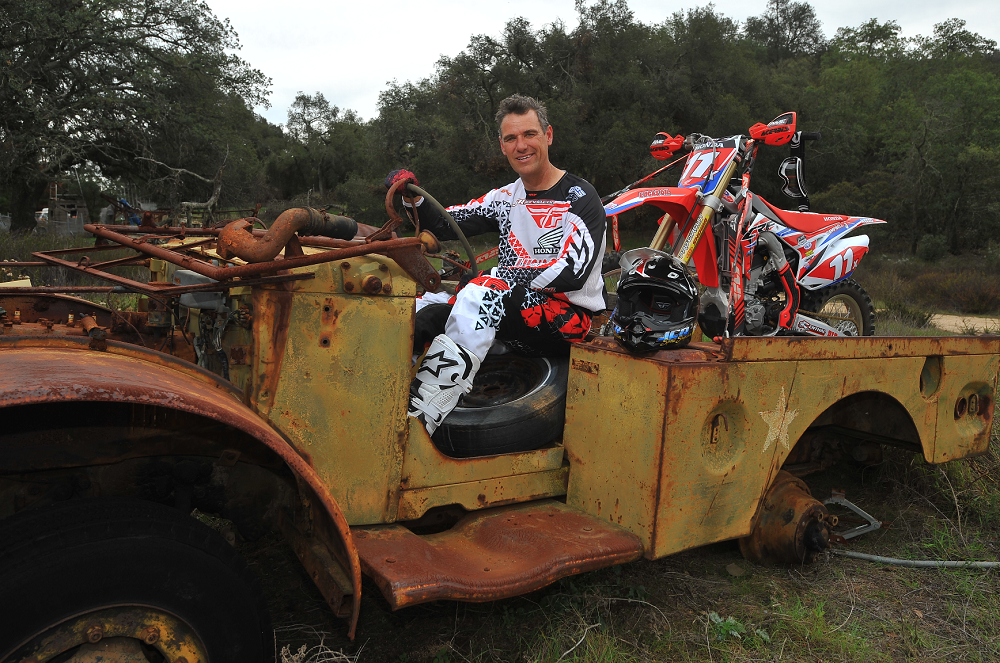 Johnny Campbell and he new pride and joy (and the CRF450RX!).
Johnny Campbell and he new pride and joy (and the CRF450RX!).
A look at Honda’s off-road race bike lineage, where it has come from and where it’s headed, points to one major thread running through it: Johnny Campbell.
The 11-time Baja champion is the head of JCR Honda (Johnny Campbell Racing), and while his roles have changed throughout his 25-year tenure at Honda, they’ve always had one thing in common—off-road racing development. Starting under the tutelage of the great Bruce Ogilvie in 1992, Campbell learned much more than how to go fast in the desert. Testing, feedback, development and innovation were constantly at work behind the scenes as Johnny and his longtime technician and friend Eric Siraton became increasingly “proactive in the development” of their race bikes. At times, that meant asking forgiveness rather than permission from the factory, but the Honda team in Japan recognized the talent at work and allowed the “American cowboys” the rein they needed to further their off-road development.
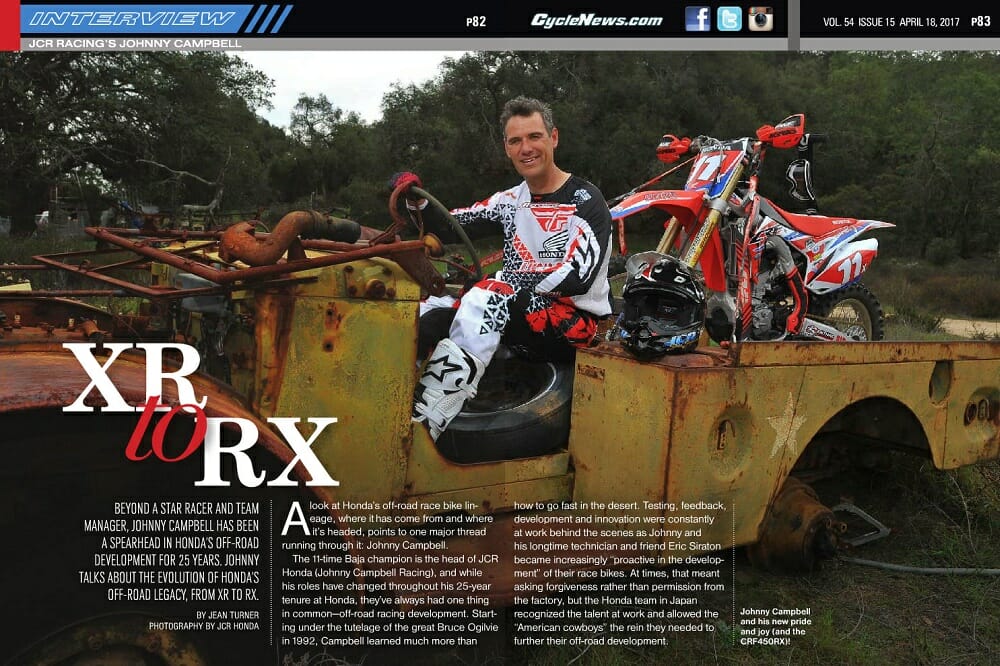
Click here to read this in the Cycle News Digital Edition Magazine.
Photography by JCR Honda
Last year hailed the arrival of Honda’s new CRF450RX, the first of an all-new platform for Big Red that fills the gap between their 450X trail bike and the 450R motocrosser. Honda’s foray into the competition off-road race bike arena has been a long time coming, and much like the 450X, and its predecessor, the venerated XR650R, the development of the RX was spurred in large part by Campbell and crew.
As with Honda, Johnny Campbell plays it close to the vest when it comes to trade secrets, but we recently sat down with him to talk about his hand in guiding the development of Honda’s off-road race bikes spanning three decades, from his early years on the XR650R all the way through to Honda’s all-new CRF450RX.
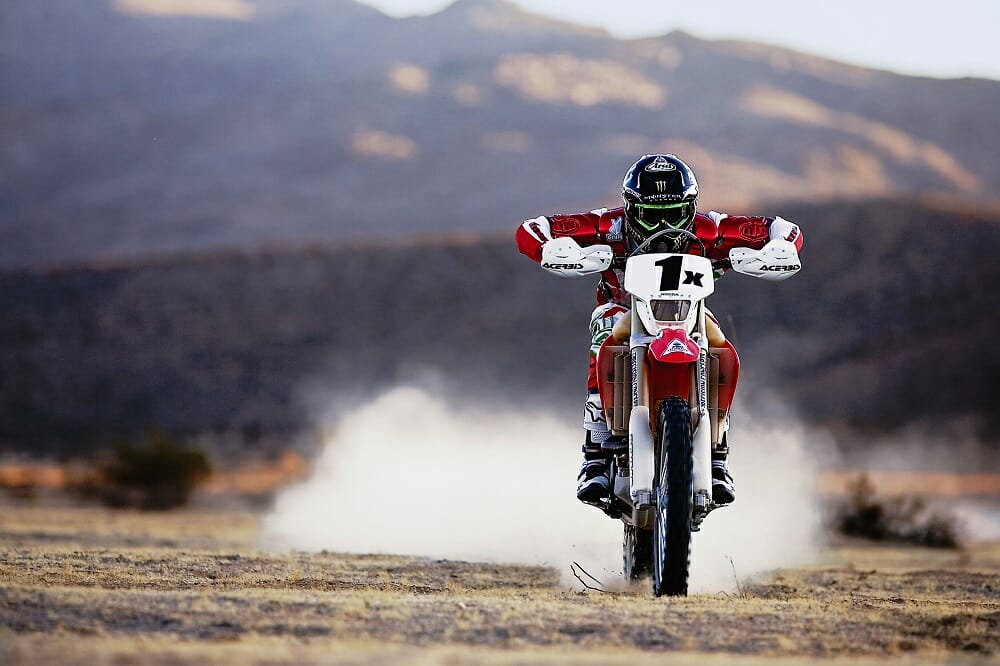 Campbell, here in his signature “JC tuck,” dominated Baja racing for more than a decade.
Campbell, here in his signature “JC tuck,” dominated Baja racing for more than a decade.
Tell us about the new RX.
The new RX model is targeted toward closed-course competition in the off-road arena. It’s more or less our cross-country bike for GNCC, WORCS racing, GP-style racing, but also very pleasing to a very wide range of customers going from even a serious motocrosser all the way to a casual trail rider. It really covered a gap in our lineup of having a full 450R motocrosser and a 450X off-roader. It has the latest technology based off the [2017] CRF450R motocross model; the R and the RX share the same chassis and suspension components. The RX has a different setting in the suspension, but same swingarm, same linkage, subframe. It’s all the same components to start with a very good base, then it’s tuned for off-road racing.
And it’s still a capable motocross bike, right?
Yeah, I really feel that the RX that is suitable for many guys that want to come race a motocross race, and want to go trail riding with their buddies. It’s like a do-it-all bike.
With the Japanese brands, that gap in the lineup between motocross and trail bikes has existed for a very long time. Were you instrumental in getting Honda to acknowledge the competition off-road segment?
You know, a few years back, Honda and I decided to change direction in my program and send me to GNCC [Grand National Cross Country], the biggest off-road racing series in the States for motorcycles. So I went back there and the first couple years, I learned a lot about the bike and the development. We took the base of the 450R motocrosser and tried to trail-tune it to a woods/cross-country off-road racer. All the little mods and updates we did to the chassis, we did to the suspension and the settings, the mapping the fuel injection, the gearing, every detail of it all the way to the tires, really, all that information that we gathered applied to this new bike, the new 450RX.
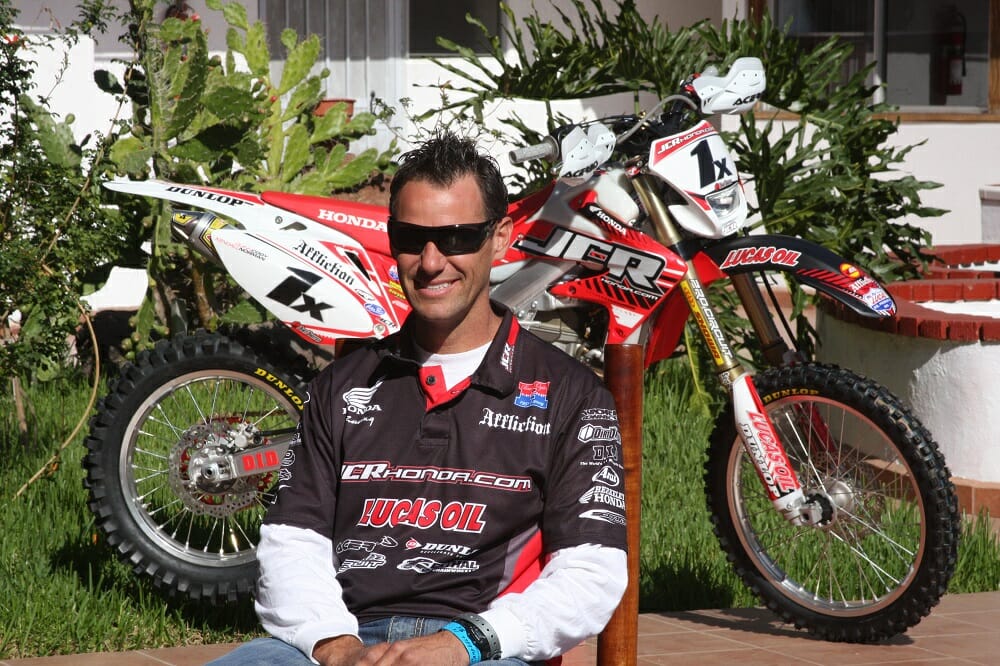 Now the head of the Johnny Campbell Racing (JCR) Factory Honda team, Johnny continues to help guide Honda off-road development.
Now the head of the Johnny Campbell Racing (JCR) Factory Honda team, Johnny continues to help guide Honda off-road development.
The competition off-road segment has been around for quite a few years—what is it that brought Honda into the fold?
It just took a series of events to happen, I think, to push technology forward. Of course, all of us were standing by a pretty bad economic time and back in ‘08 and that caused everybody to kind of buckle down, and we saw some of the other manufacturers starting to move, so of course, you can let them get out there a little ways, but you can’t let them go too far. When you see success in your competition, you either do two things: You either go for it and want to go beat them and catch them, or you go away. And Honda, they’re not dummies; they know what to do. And Honda’s certainly not a company that wants to put their tail between their legs.
You and Eric [Siraton] have had a history of shaping the Honda off-road bikes and Honda has given you a lot of leeway in that. So you can really say that you guided the development in the RX.
I can say I had a part in it. There’s a huge team behind it with Hide [Hanawa, off-road coordinator at Honda R&D North America] and Ryan Dudek and all the test and design group at HGA in Japan. It’s a combination between us as JCR, going out to the races and grinding down the series all year and learning from that process. Then we relay that information, and engineers design a bike and we get a base and then we start building the bike from there and tailoring it. It took a while to do what we wanted to do with the RX and I feel we hit the mark perfectly.
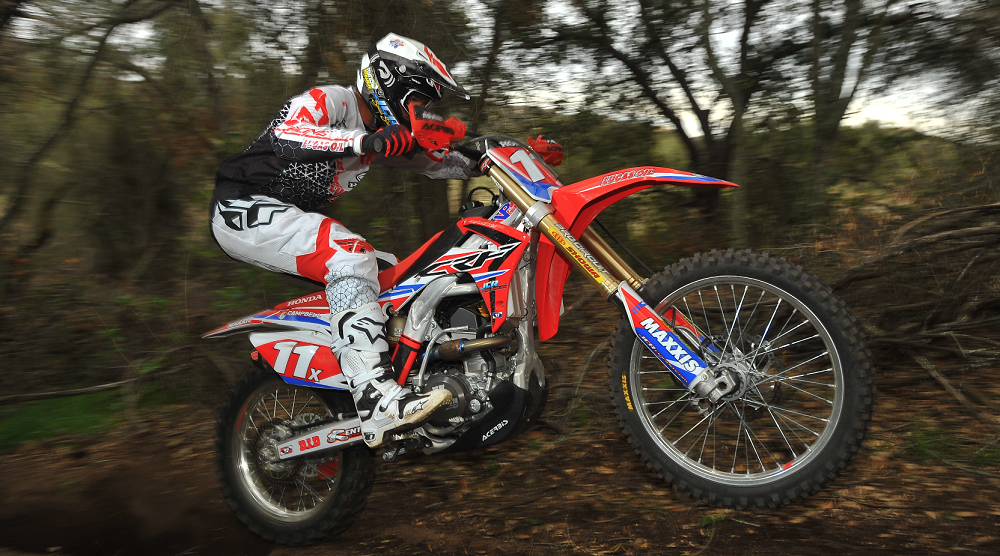 Campbell takes his all-new Honda CRF450RX for a spin near his Southern California home.
Campbell takes his all-new Honda CRF450RX for a spin near his Southern California home.
When you’re doing this sort of development and it’s going back and forth with Japan, in the end, how close is it to what you wanted? Is there a lot of compromise and pushback?
We’re really only compromised by how much budget and how much time. Between those two things, and I guess the creativity in the group, so those three things, that’s where you have to say stop at some point. Of course we always want better, better, better. But as far as reaching our target, we hit it on all fronts. That was very, very instrumental in all groups, cooperating with each other and being able to hit those dates of when things needed to be finalized and stuff. I feel we reached those goals, that target and the final product is going to turn some heads.
At the Glen Helen 24 Hour Endurance Race in 2015, we saw that Hide Hanawa was here. Were you doing some R&D on this project then?
[laughs] Well, we’re always doing R&D in every race. I can’t be specific of some of the details that we do during our racing. There’s stuff the racers don’t even know we’re doing and checking in the data that I’m supplying back to R&D. But yeah, that 24-Hour was some of the stuff we were working on.
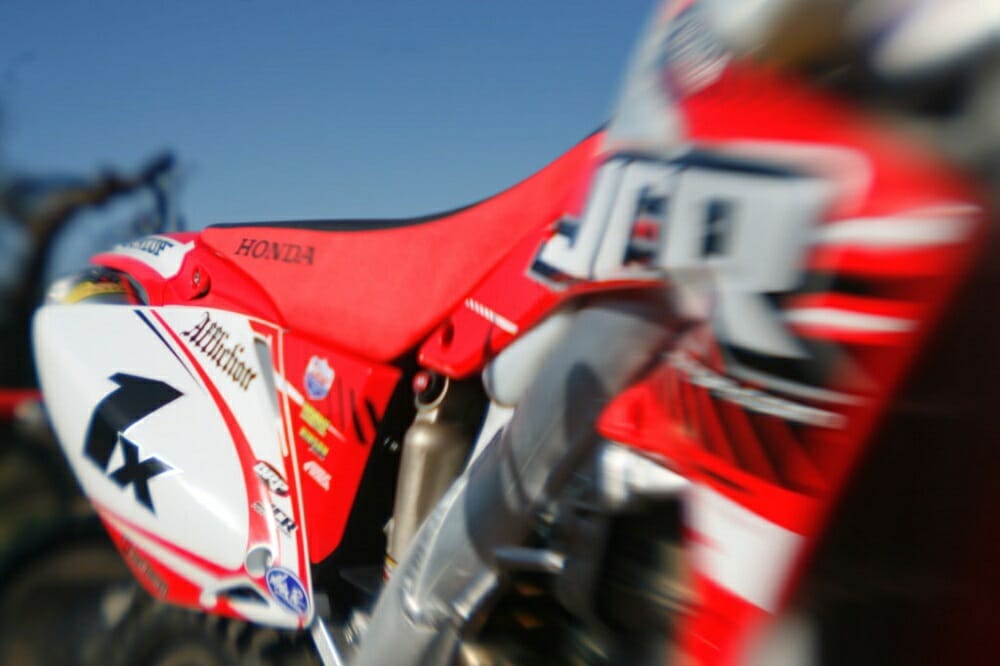 Though he has retired from racing, the 11-time Baja 1000 champion will always be synonymous with the 1X plate.
Though he has retired from racing, the 11-time Baja 1000 champion will always be synonymous with the 1X plate.
Talk about working with Bruce Ogilvie. It seems like his influence is still a big part of the development you do for Honda.
Bruce Ogilvie, my mentor and former boss and friend, was always very instrumental in guiding me along my career. I spent over 17 years under his wing. His main job, his main focus wasn’t just managing the off-road race team—that was only about 20 percent of his job. Really his job was, he was American Honda’s eyes and ears at Honda R&D as far as testing and evaluation and bringing that evaluation back to them. Bruce brought me in and educated me along my racing career and taught me how to develop motorcycles and give input that’s very valuable to the engineers.
 Dating back to 1992 and his time under Bruce Ogilvie, Campbell has been instrumental in testing and developing Honda off-road motorcycles.
Dating back to 1992 and his time under Bruce Ogilvie, Campbell has been instrumental in testing and developing Honda off-road motorcycles.
Stemming back to the XR650R, which is still a fantastic bike, to the race bikes you run today, what do you think Bruce would have to say?
Bruce wouldn’t be a bit surprised. He saw decades of evolution of off-road racing machines and I think that he’d be very proud of the efforts that we put into these models. I just got to think that the education that he gave all of us, he’d be very proud of us for putting that onto the ground and taking it from a dream to paper to all the way to the finish line.
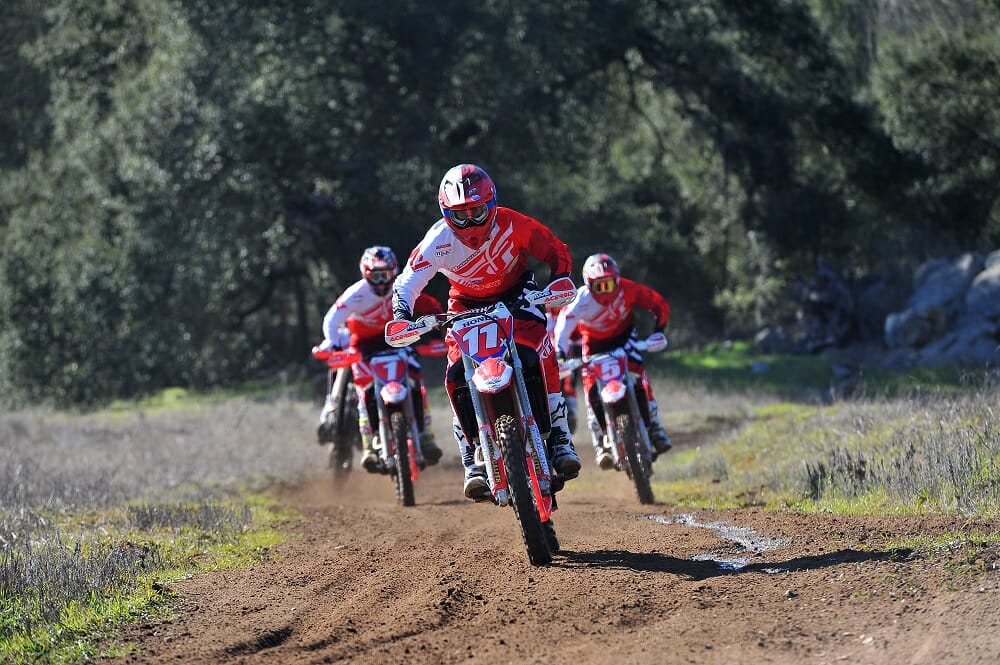 Campbell indicates that Honda’s all-new RX platform will “go further into future models.”
Campbell indicates that Honda’s all-new RX platform will “go further into future models.”
Tell us about that evolution from the XR to the RX.
Going all the way back to when I started with American Honda in 1992, the XR line was their off-road line. More or less they were off-road trail bikes. But of course, we raced them. We modified them slightly and we ended up racing them and winning Baja desert races, Scott Summers ended up winning a lot of hare scramble and GNCC titles. So the gap back then was we have a trail bike that we built into a race bike, and the two-strokes were the motocross bike. Honda’s philosophy was four-strokes are off-road bikes, and two-strokes are motocross bike. So we rode those heavy trail bikes and figured out how to win on them. Then as the years went on, technology and the public called for performance four-strokes. That was the late 90’s when we saw the development of lightweight high-performance four-strokes. That changed the philosophy a little bit as far as four-strokes are off-road bikes, they became all the bikes. [laughs] That ended up kind of branching off-road bikes with motocross bikes so to speak, and that eventually led to the development of the 450X. The 450X was a huge step forward, race wise and race performance wise, over the XR line. Because the XR was really targeted at the trail, where the 450X took a lot of its characters from its other brother, the 450R back in the early 2000s. That decade, was that step. We ran off that 450X platform for over 10 years as our off-road bike.
As time went on, we saw enough gap between the 450X and the 450R and as the races evolved and off-road racing started evolving, the need for a competition, closed-course off-road race machine came. So now it’s here, the 450RX and it’s an awesome machine. It’s going to do really well for us.
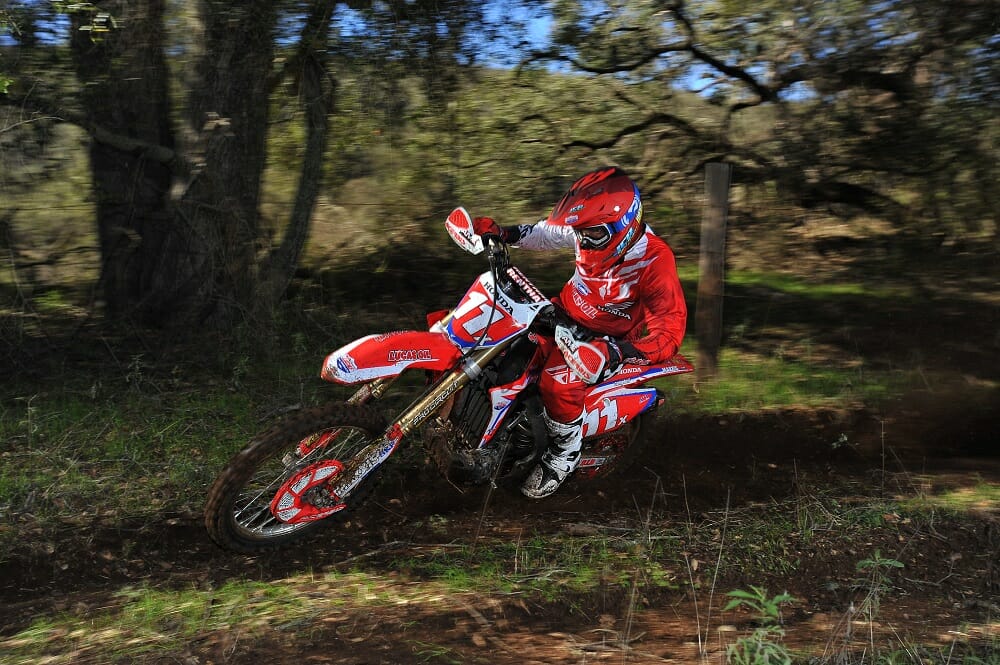 JCR Honda’s racing program has ventured out west to the GNCC series, a move that has also influenced Honda’s off-road development.
JCR Honda’s racing program has ventured out west to the GNCC series, a move that has also influenced Honda’s off-road development.
Now that there’s a new platform here, are there other bikes that might be coming? Could there be a 250 or a 350?
Certainly the platform that’s been designed over the years that turned into these production bikes we have now, certainly that information and that technology will go further into future models and bikes along the way.CN